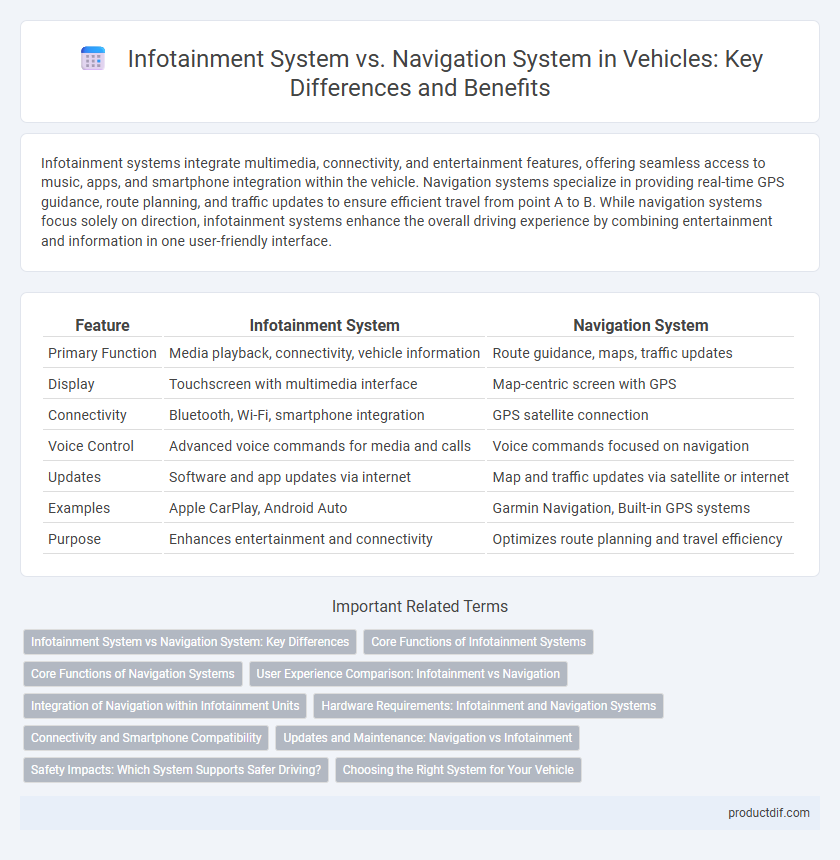Infotainment systems integrate multimedia, connectivity, and entertainment features, offering seamless access to music, apps, and smartphone integration within the vehicle. Navigation systems specialize in providing real-time GPS guidance, route planning, and traffic updates to ensure efficient travel from point A to B. While navigation systems focus solely on direction, infotainment systems enhance the overall driving experience by combining entertainment and information in one user-friendly interface.
Table of Comparison
| Feature | Infotainment System | Navigation System |
|---|---|---|
| Primary Function | Media playback, connectivity, vehicle information | Route guidance, maps, traffic updates |
| Display | Touchscreen with multimedia interface | Map-centric screen with GPS |
| Connectivity | Bluetooth, Wi-Fi, smartphone integration | GPS satellite connection |
| Voice Control | Advanced voice commands for media and calls | Voice commands focused on navigation |
| Updates | Software and app updates via internet | Map and traffic updates via satellite or internet |
| Examples | Apple CarPlay, Android Auto | Garmin Navigation, Built-in GPS systems |
| Purpose | Enhances entertainment and connectivity | Optimizes route planning and travel efficiency |
Infotainment System vs Navigation System: Key Differences
The infotainment system integrates multimedia functions such as audio, video, smartphone connectivity, and voice commands, enhancing the overall in-car entertainment experience, whereas the navigation system primarily provides GPS-based route guidance and real-time traffic updates. Infotainment systems often support applications like music streaming, Bluetooth, and hands-free calls, while navigation systems emphasize accurate mapping, turn-by-turn directions, and route optimization. Modern vehicles increasingly combine both functions, but the infotainment system focuses on entertainment and connectivity, distinct from the navigation system's core purpose of spatial orientation and travel assistance.
Core Functions of Infotainment Systems
Infotainment systems in vehicles integrate core functions such as multimedia playback, smartphone connectivity, and voice control to enhance driver and passenger experience. These systems provide access to music, radio, hands-free calling, and app integration, going beyond navigation functionalities. While navigation systems focus primarily on route guidance and mapping, infotainment systems centralize entertainment, communication, and vehicle information in a single interface.
Core Functions of Navigation Systems
Navigation systems primarily provide GPS-based route guidance, turn-by-turn directions, and real-time traffic updates to ensure efficient travel. Infotainment systems integrate multimedia entertainment, connectivity features, and vehicle information but rely on navigation systems for precise location tracking and mapping. Core navigation functions include route optimization, lane assistance, and point-of-interest search to enhance driver situational awareness and safety.
User Experience Comparison: Infotainment vs Navigation
Infotainment systems offer a comprehensive user experience by integrating multimedia, smartphone connectivity, voice control, and real-time vehicle data, enhancing in-car entertainment and convenience. Navigation systems prioritize route guidance, traffic updates, and point-of-interest searches with intuitive maps and turn-by-turn directions, optimizing trip efficiency and safety. Infotainment systems create a versatile environment for driving pleasure, while navigation systems focus on precise, user-friendly pathfinding functionality.
Integration of Navigation within Infotainment Units
Modern infotainment systems seamlessly integrate navigation functionality, consolidating multimedia, connectivity, and GPS services into a single interface. This integration enhances user experience by providing real-time traffic updates, voice-guided directions, and smartphone synchronization within the same dashboard unit. Advanced infotainment platforms leverage cloud data and AI to deliver personalized routes and interactive maps, surpassing standalone navigation systems in versatility and convenience.
Hardware Requirements: Infotainment and Navigation Systems
Infotainment systems require high-performance processors, large touchscreen displays, and multiple connectivity options such as Bluetooth, Wi-Fi, and USB ports to support various multimedia functions. Navigation systems prioritize GPS receivers, accelerometers, and dedicated mapping processors to ensure accurate real-time location tracking and route calculations. Both systems demand robust hardware integration with vehicle networks but differ in their emphasis on multimedia capabilities versus precise geolocation hardware.
Connectivity and Smartphone Compatibility
Infotainment systems offer comprehensive connectivity features, including Bluetooth, Wi-Fi, and voice control, enabling seamless smartphone integration for streaming, calls, and app access. Navigation systems focus primarily on GPS capabilities but increasingly support smartphone mirroring through Apple CarPlay and Android Auto for real-time traffic updates and route management. Enhanced smartphone compatibility in modern infotainment systems provides a unified interface for entertainment and navigation, improving driver convenience and safety.
Updates and Maintenance: Navigation vs Infotainment
Navigation systems require frequent map updates to ensure accurate routes and real-time traffic data, often provided through over-the-air updates or USB downloads. Infotainment systems receive software enhancements to improve user interface, media compatibility, and connectivity features, typically updated via wireless connections or service visits. Regular maintenance of both systems is essential to optimize performance, prevent software glitches, and maintain up-to-date functionalities.
Safety Impacts: Which System Supports Safer Driving?
Infotainment systems integrate multiple functions like audio, communication, and navigation, reducing driver distraction by enabling voice control and streamlined access, which enhances overall safety. Navigation systems provide real-time GPS guidance and traffic updates, crucial for avoiding accidents through route optimization and hazard warnings. Combining both systems with advanced driver assistance features significantly supports safer driving by minimizing cognitive load and maximizing situational awareness.
Choosing the Right System for Your Vehicle
Choosing the right system for your vehicle depends on your priorities: infotainment systems offer integrated audio, smartphone connectivity, and voice controls, enhancing entertainment and convenience on the road. Navigation systems focus on precise GPS mapping, real-time traffic updates, and route optimization to improve driving efficiency and safety. Assess features like display size, software compatibility, and user interface to ensure seamless integration with your vehicle's technology and daily driving needs.
Infotainment System vs Navigation System Infographic

 productdif.com
productdif.com